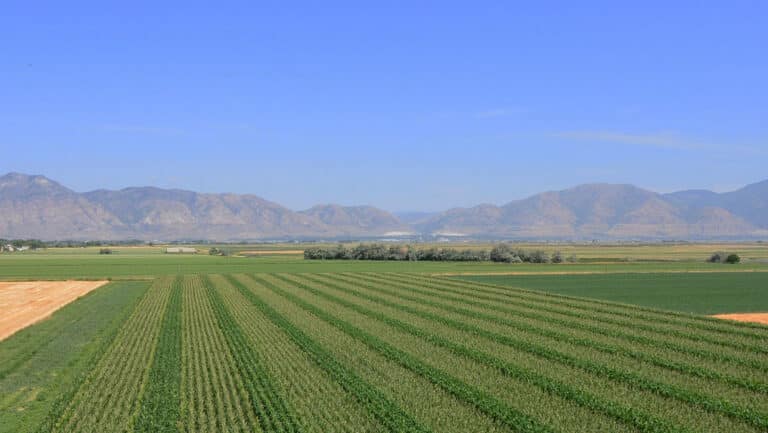How Sustainable Farming Practices Protect Land and Profitability
Agriculture has the power to change our planet.
There is a growing understanding of agriculture’s potential to be a significant part of the climate solution through the adoption of sustainable farming practices. This supports this year’s Earth Day theme of “Our Power, Our Planet.” By removing financial, informational, and logistical barriers, implementing supportive policies, and increasing investment in research and infrastructure, we can empower farmers and ranchers to embrace sustainable agriculture. Together, we can work toward both environmental sustainability and the long-term profitability of American farms.
Sustainable Farming Practices as a Climate Solution
Often, people are quick to point the finger at agriculture as a source of major emissions in the United States. But what many people don’t realize is American agriculture and forestry are uniquely positioned to not only emit greenhouse gases (GHGs) but also to sequester them, making the sector a vital ally in combating climate change.
Even the commonly held belief that agriculture is a major source of emissions due to methane production may not be based in fact. U.S. agriculture contributes a significantly lower percentage of national GHG emissions (around 10% in 2021) compared to global averages. In fact, the widespread adoption of climate-smart agricultural practices could potentially reduce U.S. agriculture emissions by more than half in 2025.
Professor Dr. Frank Mitloehner of UC Davis believes that the best approach to debunking these myths and building a more sustainable future is by working together, saying, “I am encouraged to see less of a ‘we-vs.-them’ approach and rather an attitude of ‘let’s work together to solve the problem.’”
The Benefits of Sustainable Farming Practices
When farmers implement regenerative practices, they very often get rewarded. Many farmers have seen benefits such as reduced input costs (like fertilizers and herbicides), improved soil health, and increased resilience to weather events.
“The impact, even in just three years since we’ve introduced some of these practices on a lot of our acres, is huge. We’ve been able to better withstand large rainfall events, cut back on some residual herbicide usage, and are on the cusp of beginning to run some trials to see if we can scale back our nitrogen program due to overall increased efficiency of our soil as a whole and the credit that our legume covers are giving us.”
– Aaron Krueger, fourth generation farmer in Indiana
Implementing regenerative practices doesn’t just help the land. It also can save farmers thousands of dollars. Just by implementing cover cropping, Mitchell Hora, a seventh generation Iowa farmer, was able to save $106.24 per acre in fertilizer costs alone in 2021.
How Can Farmers Implement Sustainable Farming Practices?
There are a lot of changes—big and small—farmers can make to build a regenerative operation. Some of the most common practices include:
- No-till and reduced till farming: Protects soil from erosion, improves soil quality, and reduces fuel use.
- Cover crops: Replenishes soil nutrients, prevents erosion, and suppresses weeds.
- Crop rotation and diversification: Maintains soil health, prevents nutrient depletion, and reduces disease and pest issues.
- Managed grazing: Improves forage production, soil fertility, and drought resistance.
- Anaerobic digestion: Converts waste into renewable energy and reduces methane emissions.
- Precision ag technology: Improves operational efficiency, reduces water usage, and optimizes resource management.
The Role of Finance and Policy in Sustainable Farming Practices
While many farmers would like to implement more sustainable practices, the upfront cost can be daunting. The fact is they cannot do it alone. The industry has already made great steps toward sustainability thanks to investments in research, education, and infrastructure.
“Farmers want to be a part of the process of being the solution. How do we adopt those technologies to help with that? And a lot of that’s going to take some assistance because the cash flow within American agriculture producers really isn’t there to get us to a point where we can be that solution to the problem.”
Sustainable Farming Resources
The good news is resources exist to help farmers overcome this barrier. These include:
Carbon bank initiatives
Carbon bank initiatives are programs aimed at creating a market where carbon sequestration can be valued and traded as a form of currency. These initiatives are designed to incentivize farmers and ranchers to adopt practices that remove carbon dioxide from the atmosphere and store it in the soil, thereby creating a potential long-term revenue stream for them while simultaneously reducing GHGs.
Conservation easements
Conservation easements are voluntary legal agreements that landowners make to protect the natural features of their land. They limit development to help preserve things like wildlife habitat and natural resources, especially on rural land. They can also offer income and tax benefits by selling easements to trusted organizations.
Government conservation programs
Although there have been recent concerns about funding availability for government-sponsored conservation programs, farmers should still consider them an option for the future. There are many different programs aimed to give farmers the funding they need to make changes to their operation, including:
- Environmental Quality Incentives Program (EQIP)
- Conservation Stewardship Program (CSP)
- Agricultural Conservation Easement Program (ACEP)
- Partnerships for Climate Smart Commodities (PCSC)
Learn more about these programs and funding freezes here.
Flexible financing solutions
Many agriculture lenders offer flexible loan options that farmers can leverage to invest in sustainable technology. At AgAmerica, we offer the flexibility of our interest-only loan options that can help farmers save money on their monthly payments. If you’re considering investing in sustainable farming practices, ask your lender about your options—they should work with you to ensure your long term success.
AgAmerica Can Help You Build a Better Future
At AgAmerica, we believe that what benefits the farmer benefits us all. If you’re considering investing in sustainable agriculture but you’re concerned about the capital requirements, we can help. Our flexible financing options give you the means to make an impact—on your land and beyond. Contact us today to speak with an expert about your loan options.






